We’re in the forest. It’s cool and peaceful. Tall, thin trunks reach up towards the sky, the beechwood creating stripes, almost reminiscent of prison bars. This is Fageda d’en Jordà, a single species wood in the volcanic area of La Garrotxa in northern Spain.
Catalan poet Joan Maragall dedicated a poem to this forest, describing its sweet oblivion as making him feel as though he was becoming a prisoner – the effect of those bark bars, presumably – of its silence and greenery.
We’re led on our way by local nature and hiking guide Mike Lockwood, from England but long gone native in the area. He points out how this forest (550m above sea level, a low altitude) grew over the lava flow from the nearby Croscat volcano, forming small hills or tossols. The specialness of this place is now protected.
We get to the stunning, horseshoe-shaped Croscat, the youngest and highest volcano in the Iberian Peninsula. It erupted about 11,000 years ago. Until 1982, it was quarried for volcanic gravel. Three years later Zona Volcànica de la Garrotxa was declared a natural park.
Mining created a giant gouge in the mound, creating a sort of cross-section of the volcano, and exposing Volcà del Croscat’s internal structure and colours. As you walk into the deep orange-black centre of the crater, it is consoling to think that it erupted thousands of years ago, and that it is a monogenetic volcano, meaning it only erupts once.
All this (no longer active) volcanic activity is not at all far from the madding crowds of the Costa Brava and Barcelona in northeastern Catalonia. The west of Spain is a familiar holiday destination but La Garrotxa is a lesser-known gem, close to Girona airport and about an hour’s drive inland from the beaches and Barcelona. The volcanic region has distinctive locally produced food, great hiking and biking, and characterful villages.
Tucked between Costa Brava and the Pyrenees, some 100km north of Barcelona and 60km from Girona airport is Olot, the capital of La Garrotxa. Pronounced Garrot-cha, it’s a comarca (county) in Girona province in Catalonia/Catalunya (Catalan)/Cataluña (Spanish); there are multilingual signs all over, a regular reminder of the region’s push for independence. It’s typical northern Iberian countryside with quiet villages, valleys, fertile agricultural land, masies (Catalan farmhouses) – and dormant volcanoes.
Those volcanoes are dotted all over the landscape of the southern Garrotxa, and although they are monogenetic, their imprint is everywhere, an unexpected reality in the lush countryside punctuated by their mini-bumps, and in the quiet villages or medieval towns.
We made Olot our base: it’s a typical Catalan small city of 30,000 people, attractive, bustling and vibrant on a plain surrounded by mountains. It’s striking architecturally, with modernist or Art Nouveau buildings from the early 20th century, many of them designed by Alfred Paluzie. We spent a happy couple of hours at day’s end wandering around the historic town centre with guide Eva Calvet and a one-page leaflet from the tourist office, receiving a tour of casa with iron balustrades, decorated with sculptural animals, glazed floral tiles, and towers and friezes.
Also of interest in Olot are the classical Baroque Tura Church, the 16th-century convent Claustre del Carme, and the modern indoor food market Plaça Mercat, where I bought some sausage and an intriguing, layered meat and fish bake.
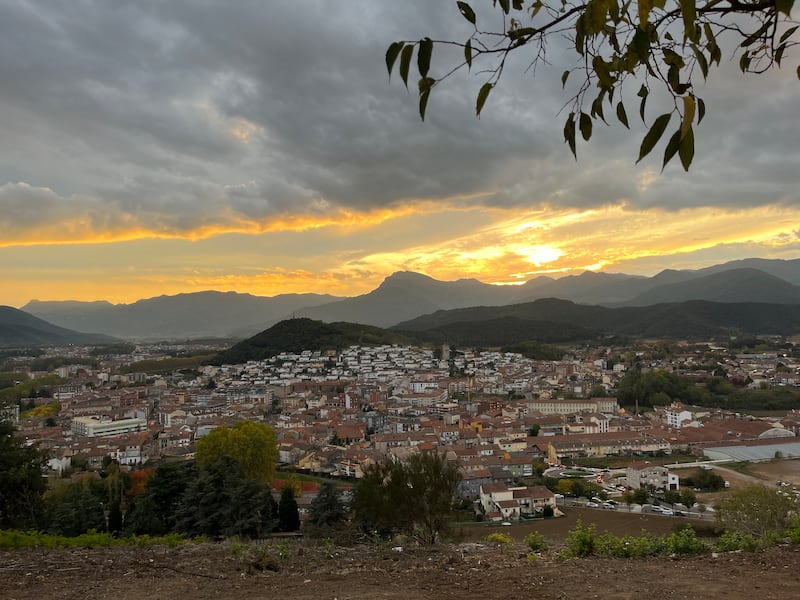
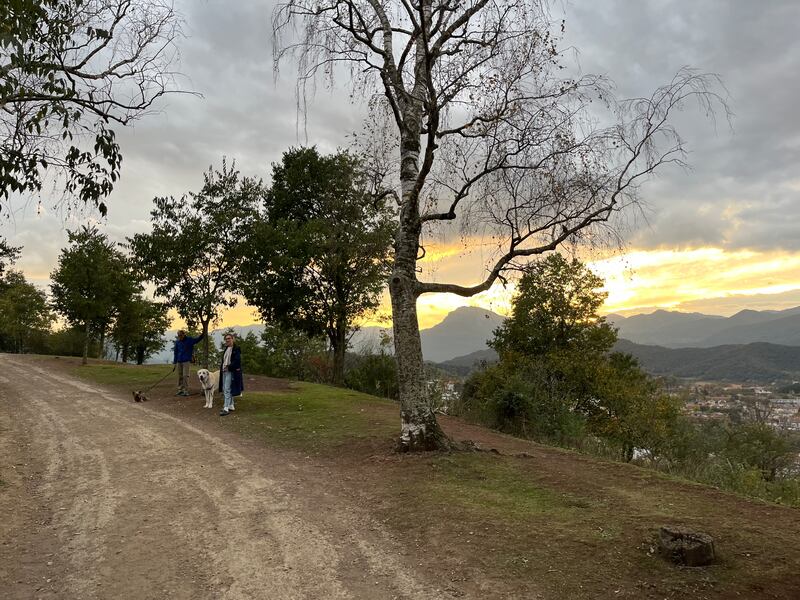
One of the most distinctive aspects of Olot is that it grew around four volcanoes scattered around the city centre. With guide Beth Cobo we turned off a street near the cemetery and found ourselves walking on black volcanic materials at the base of Volcà del Montsacopa, then heading uphill through the woodland that now covers the crater. You walk around the volcano’s rim, punctuated by two watchtowers and the church of Sant Francesca, with a restaurant beside it. Some 130,000 years ago Montsacopa erupted, but today some children are playing on the grass inside the crater, and it functions like a (highly unusual) town park.
Across the road from the base of Montsacopa is Espai Cràter, an underground museum within another volcano: the ancient Puig del Roser. You seem to enter this impressive volcano museum through a red crack in the mound, bringing you into the very earth itself.
The La Garrotxa volcanic area is one of the most significant in Europe and the Garrotxa Volcanic Zone Natural Park comprises 15,000 hectares, much of it privately owned, but all of it protected and with walking trails. As well as about 40 volcanic cones there are more than 20 lava outflows. While the volcanoes are dormant, the region is still seismically active, with about 100 almost imperceptible seismic movements every year.
There are several well-preserved medieval villages in the area, most strikingly Castellfollit de la Roca, made of stone and wood, and perched on a 50m-high, 1km-long volcanic cliff, with the layers of its geological history visible. Santa Pau is close to fageda d’en Jordà and in the middle of volcano country and fertile farmland. Founded in the 13th century, it’s well conserved, with narrow streets of stone houses, a large square surrounded by arcaded buildings, a Romanesque church and alleys.
It’s faster to get around the region by car, but travelling by bus is another option.
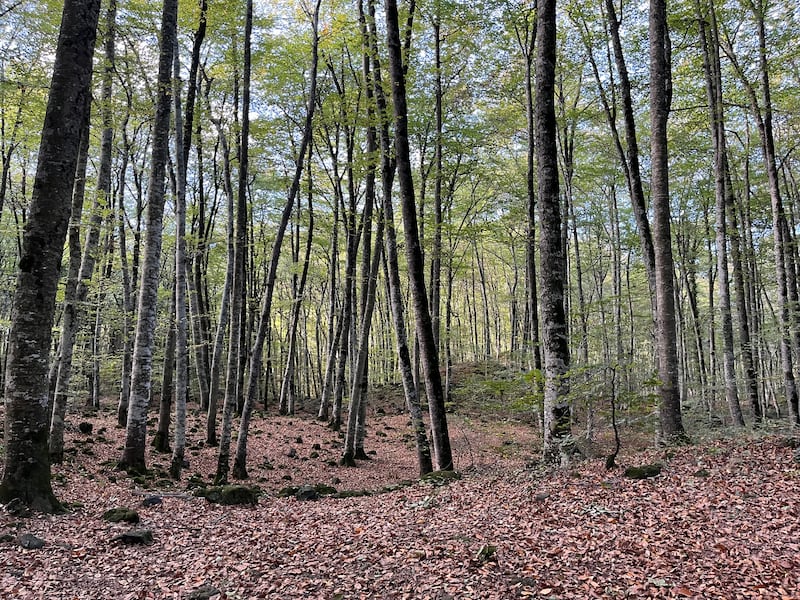
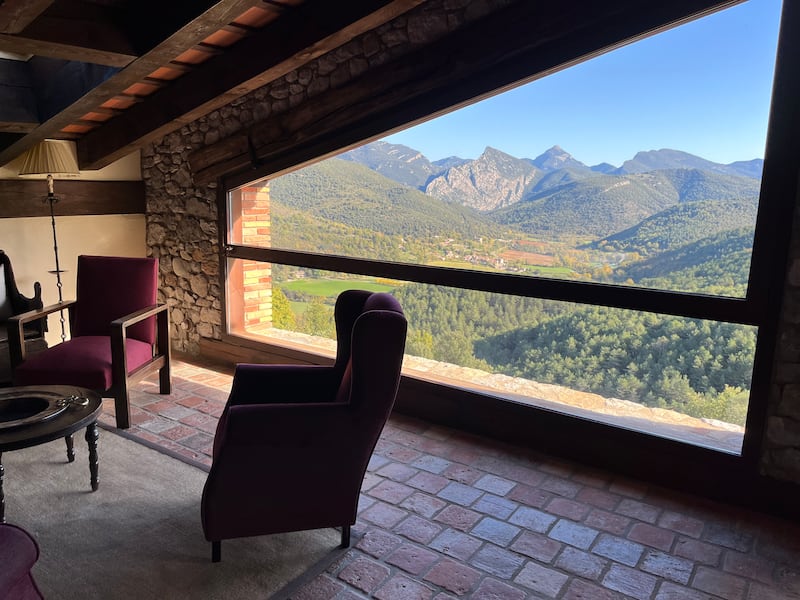
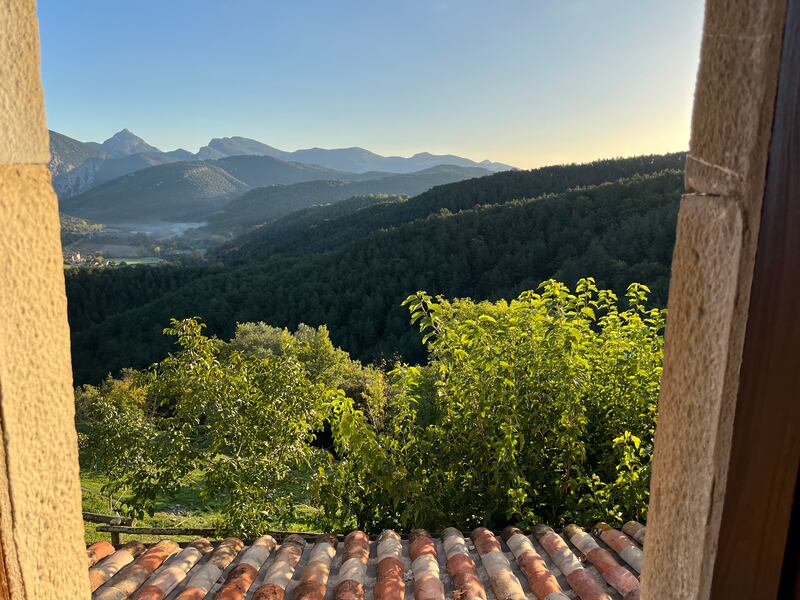
The eating is good, too. There’s a lot of talk in La Garrotxa about “volcanic cuisine”, by which they don’t mean fiery hot, but rather using quality local produce including beans, buckwheat, snails, truffles, pork and bread. We had a terrific value lunch at Restaurant l’Hostalet, an eatery in a stone building with arched roofs in La Vall d’en Bas, a village between Olot and Vic.
Supper in L’Hostal del Sol, a traditional roadside tavern outside Olot, involved a great selection of local cheeses (plus others in a big pot of fondue) and cured meats from the area, with pa amb tomàquet (Catalan tomato bread), served on giant boards. Another lunch was on the terrace of the bright, airy Restaurant La Quinta Justa in the centre of Olot, involving more excellent local produce and Catalan dishes, and a range of price points.
In Olot we stayed at Hotel Vall d’en Ba, located a few kilometres outside town. An 18th-century building in origin, with more recent add-ons, it was spacious, comfortable, gracious and calm.
Whereas that hotel was well positioned for touring the area, the gorgeous Mas Pineda in Oix is more of a remote retreat. A 16th-century farmhouse converted into luxury accommodation, each of the bedrooms is individually decorated, with original stone and antique furnishings. You reach it after a long and rough trail up a mountain near Oix village. The compound features fantastic views of the valley, with snow-capped Pyrenees in the background. While there, we experienced a forest bath, a sensual and calming, blindfolded experience.
La Garrotxa has an Atlantic climate, with more rain than you’d expect, and the best time to visit, avoiding the heat of high summer, is in spring or autumn. It is at a sweet spot: a lesser-discovered part of Catalunya but incredibly easy to access.
Deirdre Falvey travelled as a guest of Spain’s Ecotourism Club, Spanish Tourism Office in Dublin, Patronat de Turisme Costa Brava Girona and Turisme Garrotxa











